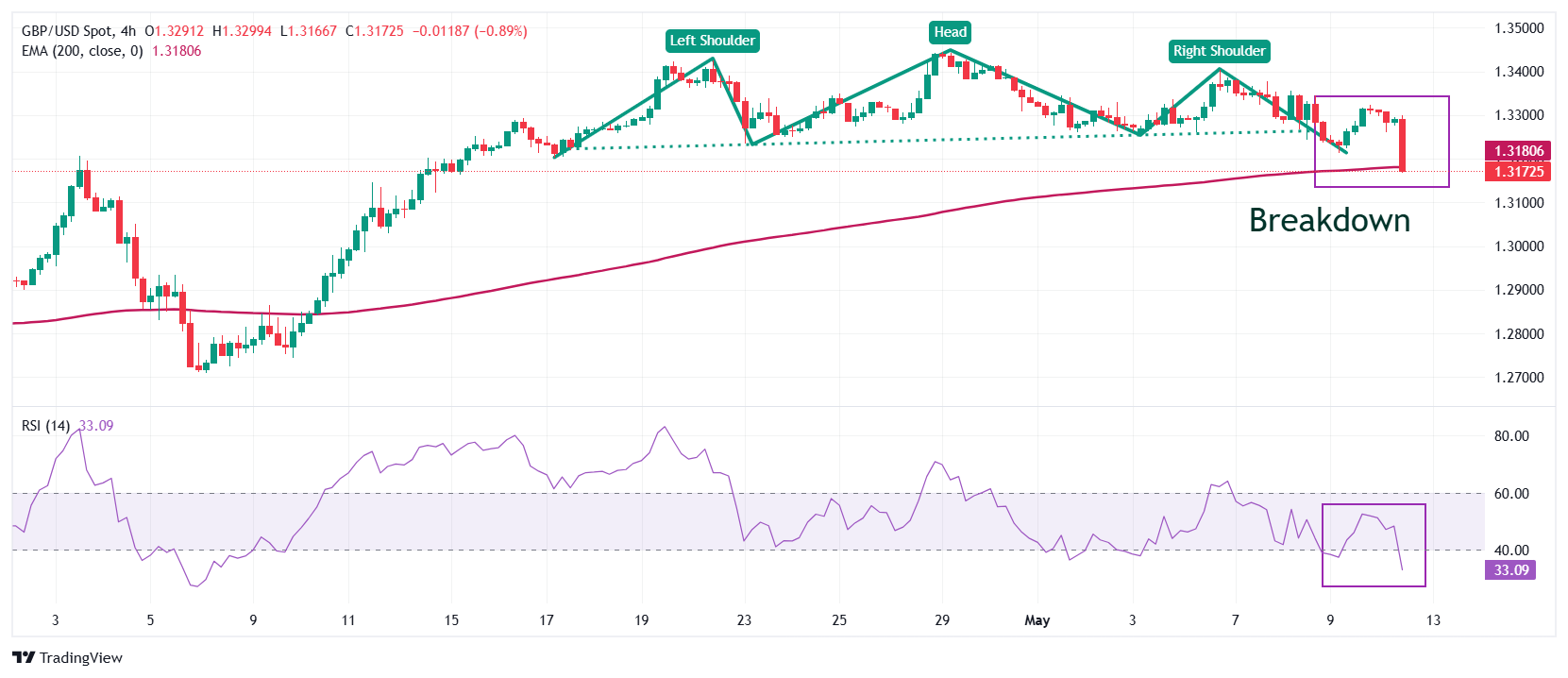- The sterling pound falls sharply below 1,3200 against the US dollar after the US and China agree to reduce tariffs for 90 days by 115%.
- The reduction of tariffs in the US would pave the way for the Fed to cut interest rates.
- This week, investors will focus on the United Kingdom employment data and the US CPI on Tuesday.
The sterling pound (GBP) collapses to about 1,3170 against the US dollar (USD) and quotes about a minimum of one month on Monday. The GBP/USD torque falls sharply as the US dollar is strengthened after the United States (USA) and China agreed a reduction in tariffs imposed in the commercial war in April, which will enter into force on Wednesday, for 90 days.
The US dollar index (DXY), which tracks the value of the dollar against six main currencies, triggers about 101.80, the highest level since April 10.
The US Treasury Secretary, Scott Besent, has announced at a scheduled conference during European negotiation hours that both Washington and China have agreed to reduce import tariffs by 115%, Reuters reported. This indicates that current tariffs on the US and China are 10% and 30%, respectively. Besent declared that fentanyl -related problems have not yet been solved. Therefore, China tariffs remain 30%.
The impact of trade resolution between the US and China is favorable for most assets classes worldwide, especially for the US dollar and US assets, which were largely sold when the commercial war between the two largest economic countries in the world intensified after Beijing announced counteracting tariffs. The dollar has fallen more than 6% since the US president, Donald Trump, announced reciprocal tariffs on the so -called Liberation Day.
Meanwhile, the resolution of the commercial war between the US and China will also reduce the high expectations of consumer inflation in the US, a scenario that will pave the way for the Federal Reserve (Fed) to resume the cycle of relaxation of monetary policy, which paused in January.
Besent’s comments, the US trade representative, Jamieson Greer, and Vice Minister of Commerce of China, Li Chenggang, have indicated that both nations have achieved a “substantial progress” in high -risk commercial conversations in Geneva during the weekend.
The two -day meeting between the US and its Chinese counterparts during the weekend in Switzerland has managed to deactivate the current commercial war between the US and China. “I am pleased to inform that we have achieved substantial progress between the US and China in the very important commercial conversations,” said Besent, said Yahoo Finance.
“We are sure that the agreement we reach with our Chinese partners will help us work to resolve the trade deficit,” said US trade representative, Greer. On the other hand, Vice Minister of Commerce of China, Li Chenggang, said he would contain “good news for the world.”
What moves the market today: the pound sterling wins in front of its peers, except the US dollar
- The sterling pound is listed up against its main peers, except the US dollar, at the beginning of the week. The British currency demonstrates firmness since the Bank of England (BOE) maintained its “gradual and cautious” monetary expansion guide in the policy announcement on Thursday.
- The BOE reduced its interest rates in 25 basic points (PBS) to 4.25%, as expected, but with a divided vote in which the member of the Monetary Policy Committee (MPC) Catherine Mann and the chief economist Huw Pill voted to maintain interest rates without changes. On Friday, Pill clarified that his decision was based on expectations that long -term internal pressures could increase inflation, Reuters reported. Pill also minimized the impact of global commercial risk on the United Kingdom economy. “I don’t see a dramatic change in the United Kingdom economy after tariff advertisements,” Pill said.
- On the contrary, the governor of the BOE, Andrew Bailey, warned a few weeks ago that the Central Bank should consider the risks of the commercial war.
- This week, the GBP/USD torque will be influenced by the United Kingdom’s employment data for the three months that ended in March and the US Consumer Price Index (CPI) for April, which will be published on Tuesday. The data of the United Kingdom labor market is expected to show that the unemployment rate accelerated and that salary growth grew at a slower pace. Meanwhile, it is estimated that the U.S. underlying inflation has grown at a faster rate in monthly terms.
Technical analysis: The sterling pound breaks below the graphic pattern of H&S

The sterling pound slides below 1,3200 against the US dollar at the beginning of the week. The perspective of the torque has become bassist after a break in the head and shoulder pattern (H&S) in a temporary frame of four hours. A break of the H&S graphic pattern leads to a bassist reversal, and its formation near critical resistance increases its credibility.
The cable slides near the exponential mobile (EMA) average of 200 periods, which is around 1,3190, suggesting a bearish trend.
The relative force index (RSI) of 14 periods falls below 40.00. A new bearish impulse would be activated if the RSI is maintained below that level.
On the positive side, the maximum of three years of 1,3445 will be a key obstacle to the torque. Looking down, the psychological level of 1.3000 will act as an important support area.
LIBRA ESTERLINA FAQS
The sterling pound (GBP) is the oldest currency in the world (886 AD) and the official currency of the United Kingdom. It is the fourth most commercialized currency exchange unit (FX) in the world, representing 12% of all transactions, with an average of $ 630 billion a day, according to data from 2022. Its key commercial peers are GBP/USD, which represents 11% of FX, GBP/JPY (3%) and EUR/GBP (2%). The sterling pound is issued by the Bank of England (BOE).
The most important factor that influences the value of sterling pound is the monetary policy decided by the Bank of England. The Bank of England bases its decisions itself has achieved its main objective of “price stability”: a constant inflation rate of around 2%. Its main tool to achieve this is the adjustment of interest rates. When inflation is too high, the Bank of England will try to control it by raising interest rates, which makes access to credit for people and companies more expensive. This is generally positive for sterling pound, since higher interest rates make the United Kingdom a more attractive place for global investors to invest their money. When inflation falls too much it is a sign that economic growth is slowing down. In this scenario, the Bank of England will consider lowering interest rates to reduce credit, so that companies will borrow more to invest in projects that generate growth.
Published data measure the health of the economy and can affect the value of sterling pound. Indicators such as GDP, manufacturing and services PMI and employment can influence the direction of the sterling pound.
Another important fact that is published and affects the pound sterling is the commercial balance. This indicator measures the difference between what a country earns with its exports and what you spend on imports during a given period. If a country produces highly demanded export products, its currency will benefit exclusively from the additional demand created by foreign buyers seeking to buy those goods. Therefore, a positive net trade balance strengthens a currency and vice versa in the case of a negative balance
Source: Fx Street
I am Joshua Winder, a senior-level journalist and editor at World Stock Market. I specialize in covering news related to the stock market and economic trends. With more than 8 years of experience in this field, I have become an expert in financial reporting.







